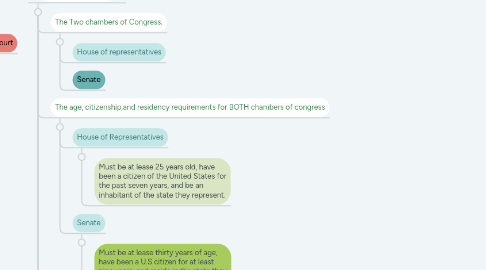
1. Judicial
1.1. Qualifications to be a member of the Supreme Court.
1.1.1. There are no restrictions or rules to be a member of the Supreme Court
1.2. How a member of the Supreme Court is selected and Approved
1.2.1. They are selected by a president then approved by the senate.
1.3. How many justices are there?
1.3.1. Nine
1.4. What is the total of the Head Justice
1.4.1. Chief Justice
1.5. How long can they serve
1.5.1. For life, either retirement or they die.
1.6. What powers does the Supreme Court have.
1.6.1. Their rulings can not be appealed.
1.6.2. They can pass bills into laws.
1.6.3. New Topic
2. Legislative
2.1. The Two chambers of Congress.
2.1.1. House of representatives
2.1.2. Senate
2.2. The age, citizenship,and residency requirements for BOTH chambers of congress
2.2.1. House of Representatives
2.2.1.1. Must be at lease 25 years old, have been a citizen of the United States for the past seven years, and be an inhabitant of the state they represent.
2.2.2. Senate
2.2.2.1. Must be at lease thirty years of age, have been a U.S citizen for at least nine years, and reside in the state they represent.
2.3. Current number of Senators and members in the House of Representatives.
2.3.1. Senators:100
2.3.1.1. Each state gets two senators.
2.3.2. House of Representatives: 435
2.3.2.1. The amount of representatives per state is based off of state population.
2.3.3. In total there are 535 members in congress
2.4. The powers of the Legislative Branch
2.4.1. Makes all Laws
2.4.2. Declares Wars
2.4.3. Regulates interstate and foreign comerce.
2.4.4. Controls Taxing and Spending policies
2.4.5. Can Impeach and remove federal workers (Judges, presidents, etc.)
2.4.6. Confirms the presidents judicial nominations
2.5. The term lengths for the Senate and House Of Representatives.
2.5.1. Senate
2.5.1.1. The Senate serves six-year terms
2.5.1.2. Elections in the Senate are staggered over even years so that only about 1/3 of the Senate is up for reelection during any election.
2.5.2. House of Representatives
2.5.2.1. The House of Representatives serve two-year terms and are considered for reelection every even year.
2.6. Implied Powers (Elastic Clause) and Expressed (or enumerated) Powers.
2.6.1. Implied Powers
2.6.1.1. Implied Powers are political powers granted to the United States government that aren't explicitly stated in the Constitution. They're implied because similar powers have set a precedent.
2.6.2. Expressed Powers
2.6.2.1. Expressed (Or enumerated) Powers are those specifically stated in the Constitution.
2.6.2.2. Congresses Powers are most clearly expressed in Article I.
3. Executive
3.1. The powers of the Executive branch
3.1.1. The powers of the executive branch include: *Being able to veto, or reject, a proposal for a law. *Appoint federal posts, such as members of government agencies. *Negotiate foreign treaties with other countries. *Appoint federal judges. *Grant pardons, or forgiveness, for a crime.
3.2. The roles of the President
3.2.1. Chief of state
3.2.1.1. Refers to the President as the head of the government.
3.2.2. Chief of executive
3.2.2.1. The president is the Chief executive as stated in the constitution with broad executive powers.
3.2.3. Chief administrator
3.2.3.1. As chief administrator the president is in charge of the executive branch of the federal government. Fun fact, this branch employs more than 2.7 billion people.
3.2.4. Chief diplomat
3.2.4.1. The president is the chief diplomat, the author of American foreign policy. Everything he says and does is closely by the American citizens and other countries.
3.2.5. Commander in Chief of the Armed Forces
3.2.5.1. President has direct and immediate control over the military.
3.2.6. Chief Legislator
3.2.6.1. The president shapes foreign policy, the president may suggest, request, and insist that congress intact laws that he believes are needed. However, congress can disagree with the president and vote against legislation
3.2.7. Head of Party
3.2.7.1. President is the leader of the political party that controls the executive branch. For example at the time I am making this (2020) Our current president is Donald J. Trump, head of the Republican Party.
3.2.8. Chief Citizen
3.2.8.1. The president should represent all the people of the United States
3.2.8.2. The president should represent all the people of the United States.
3.3. The qualifications for the president and Vice President
3.3.1. To be president
3.3.1.1. To be president A citizen has to be a natural born citizen of the United States, a resident for 14 years, and 35 years of age or older.
3.3.2. Vice President
3.3.2.1. be a natural-born U.S. citizen; be at least 35 years old; be a resident in the U.S. for at least 14 years.
3.4. The term length and Limit
3.4.1. The term length for the president is a four-year term, with a term limit of two terms (totaling eight years) or a maximum of ten years if the president acted as president for two years or less in a term.
3.5. The number of Executive Departments and the Executive Departments names.
3.5.1. Department of State
3.5.1.1. Created July 27, 1789
3.5.1.2. Head is Mike Pompeo
3.5.1.3. Is responsible for carrying out U.S. foreign policy
3.5.2. Department of Treasury
3.5.3. Department of Defense
3.5.4. Department of Justice
3.5.5. Department of Interior
3.5.6. Department of Agriculture
3.5.7. Department of Commerce
3.5.8. Department of Labor
3.5.9. Department of Health and Human Services
3.5.10. Department of Housing and Urban Development
3.5.11. Department of Transportation
3.5.12. Department of Energy
3.5.13. Department of Education
3.5.14. Department of Homeland Security
3.5.15. Department of Veterans Affairs
